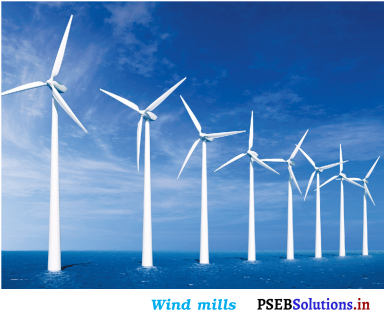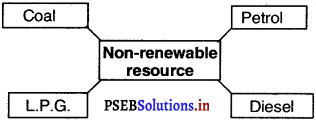Punjab State Board PSEB 5th Class EVS Book Solutions Chapter 22 Natural Resources Textbook Exercise Questions and Answers.
PSEB Solutions for Class 5 EVS Chapter 22 Natural Resources
EVS Guide for Class 5 PSEB Natural Resources Textbook Questions and Answers
Textbook Page No. 152
Question 1.
Why do leopards and other wild animals come towards the residential areas?
Answer:
Living area for the leopards and other animals is decreasing because of deforestation. Men have destroyed their habitats and thus food for them is also reduced. In search of food and habitat they come towards residential areas.
![]()
Question 2.
Has any such incident happened in your area that a wild animal entered a residential area and caused harm 7 If not, you might have heard any such incident on television or read in a newspaper. Write it down with the help of your teacher.
Answer:
A sambhar came in our area. It ran here and there and in this way some crops were destroyed. People called police and forest department. They controlled it, caught it and left it in the forest.
Textbook Page No. 153
Question 3.
What are natural resources? List different types of natural resources.
Answer:
These are resources which are available in nature e.g. air, coal, water, soil, petroleum, natural gas, forests.
Question 4.
Given below is one example each of renewable and non-renewable resources. Complete the list.
| Renewable Natural Resources Forest | Non-renewable Natural Resources Coal |
Answer:
| Renewable Natural Resources Forest | Non-renewable Natural Resources Coal |
| Air | Petroleum |
| Water | Natural gas |
| Soil |
![]()
Activity 1
Select a branch of the tree without breaking it from the tree. Cover this branch with dry polythene bag and tie its free end tightly. Observe it on the second day.
What do you observe? Do you see some water droplets inside the polythene bag? Where does this water come from? Find out and note down the answer in your notebook.
Answer:
Do it yourself.
Textbook Page No. 154
Question 5.
What products are obtained from forests?
Answer:
Fruits, rubber, gum, medicinal herbs, vegetables and colours are obtained from the forests.
Question 6.
How do forests help in making the soil fertile?
Answer:
Various trees and plant parts like branches, fruits, leaves, flowers etc. fall down on ground. These parts decay and make soil fertile by mixing in it.
Textbook Page No. 155-156
Question 7.
Why are forests being cut?
Answer:
Population is increasing day by day. Therefore, more land is required for residential area, for agricultural purposes, for industry, for roads, railway lines, for development new cities etc. This need of land is met by cutting forests.
Question 8.
What would you do to save the forests?
Answer:
- Use less paper, since paper is made from wood pulp.
- Avoid use of wood, we can use iron, aluminium etc. instead.
- We should help the organization, which are there to save forests We can help them by giving money.
![]()
Activity 2
Let us understand the principle of wind mill.
- Take a square sheet of paper.
- Give a cut from all the four sides towards the centre of the paper.
- Fold the paper from four comers towards the centre and put a pin.
- Insert the pm m the straw and bend it a little.
- Hold it in your hand and run or hold tliis in front of a running fan, it would start rotating.

Steps to make paper fan by paper folding

![]()
Question 9.
Which gas do plants use from the atmosphere for photosynthesis?
Answer:
Carbon dioxide.
Textbook Page No. 157
Question 10.
Which gas is used by living beings for respiration?
Answer:
Oxygen.
Question 11.
Which gas is released out by living beings during respiration?
Answer:
Carbon dioxide.
Textbook Page No. 158
Question 12.
Listed below are some activities, which of these activities cause pollution and which do not?
(a) Burning of wood – ………………….
(b) Filling the tyres – ………………….
(c) Breathing – ………………….
(id) Burning crackers – ………………….
(e) Working of fan – ………………….
(f) Storm – ………………….
(g) Burning the wastes – ………………….
(h) Burning crop residue – ………………….
Answer:
(a) Burning of wood – Yes
(b) Filling the tyres – No
(c) Breathing – No
(d) Burning crackers – Yes
(e) Working of fan – No
(f) Storm – No
(g) Burning the wastes – Yes
(h) Burning crop residue – Yes
![]()
Textbook Page No. 159
Question 13.
In which day-to-day life activities do you use water?
Answer:
Water is necessary for all living organisms for drinking for cleaning things, in agriculture for irrigation, shipping, industries, fish farming, water is used in hydroelectric power houses to generate electricity.
Question 14.
What steps would you take to curb the wastage and pollution of water during our daily activities?
Answer:
- During brushing our teeth we should turn off the tap.
- Reusing water for irrigation after washing vegetables, fruits etc.
- Water left after washing clothes should be used to wipe and to clean the floors.
- Cars should be cleaned by wet cloth.
Textbook Page No. 160
Question 15.
In which day-to-day life activities do you use soil?
Answer:
In the field, making bricks, constructing houses, making utensils etc.
Question 16.
Give suggestion to reduce soil pollution.
Answer:
- Do not use chemical fertilizers.
- Use of polythene, plastic, thermocol should be avoided.
- By not using insecticides, pesticides, weedicides etc.
- By saving the soil, which can be blown off or can be washed away by planting more trees.
![]()
Textbook Page No. 161
Activity 3
Which certificate regarding pollution is essential for a driver? This certificate is related to the protection of which natural resource? Try to find out with the help of your teacher.
Answer:
Pollution under control certificate. This certificate is related to the protection of petrol and diesel.
Activity 4
Ask your mother which fuel does she use in the kitchen? Is it a renewable or non-renewable resource? What steps does she take to save fuel?
| Name of fuel used at home | Non-renewable or renewable | Methods to conserve fuel |
Answer:
| Name of fuel used at home | Non-renewable or renewable | Methods to conserve fuel |
| Coal | non-renewable | use renewable sources |
| L.P.G. | non-renewable | more and avoid the |
| Solar Energy | renewable | use of non-renewable sources |
![]()
Question 18.
How do you use air in your day-to-day life?
Answer:
Respiration, for burning fire, kite flying, to remove husk from grains.
Question 19.
Which gas is used and which gas is released in the atmosphere when fuel is burnt in scooters, cars, trucks etc?
Answer:
Oxygen is used during burning and carbon dioxide is released after burning of the fuel.
Question 20.
List the causes of pollution.
Answer:
Air pollution is caused by following activities :
- Burning garbage, crop remains, leaves etc.
- Due to forest fires.
- Leaving and dumping garbage in open.
- Smoke coming out from household activities, automobiles, industries, cigarettes etc.
- Fire crackers produce a lot of smoke.
Question 21.
What steps would you take to save the air from pollution?
Answer:
- By reducing the use of cars and other vehicles. By carpooling.
- We should switch off the vehicles at red lights.
- By not burning garbage and crop remains.
- By not using fire crackers.
PSEB 5th Class EVS Guide Natural Resources Important Questions and Answers
1. Tick the correct option :
(i) Water is used.
(a) in shipping ( )
(b) in industries ( )
(c) for irrigation ( )
(d) all ( )
Answer:
(d) all
![]()
(ii) Non-renewable natural resources are.
(a) Coal ( )
(b) L.P.G. ( )
(c) petrol ( )
(d) all ( )
Answer:
(d) all
(iii) Which one is renewable Natural resource?
(a) coal ( )
(b) air ( )
(c) petrol ( )
(d) kitchen gas ( )
Answer:
(b) air
2. Answer in one/two lines :
Question 1.
How is soil wasted by natural processes?
Answer:
Due to floods and due to wind fertile soil is wasted.
Question 2.
Give one use of air.
Answer:
Wind mills are used to generate electric power using air.
![]()
3. Fill in the blanks :
(i) Forests are important resources.
(ii) During photosynthesis plants take gas and release gas.
(iii) gas is required for burning fuel.
(iv) is non-renewable natural resource.
Answer:
(i) natural,
(ii) carbon dioxide, oxygen,
(iii) oxygen,
(iv) coal.
4. True/False :
(i) World environment day is cele¬brated on 5th June.
(ii) Due to transpiration trees lose water in the atmosphere.
(iii) Soil is one of the natural resource. Answer:
(i) T,
(ii) T,
(iii) T.
5. Match the following column :
(A) – (B)
(i) World earthday – (a) First week of July
(ii) Van mahotsav – (b) Non-renewable source
(iii) Coal – (c) 22 April
(iv) Wind – (d) Renewable
source.
Answer:
(i) (c),
(ii) (a),
(iii) (b),
(iv) (d).
![]()
6. Mind Map :

Answer:

7. Answer in five/six lines :
Question 1.
How forests are beneficial for us?
Answer:
Forests are very important natural source. These are important for maintaining balance in the nature. Forests release oxygen in the atmosphere and absorb carbon dioxide that too in large amounts. Therefore they are helpful in maintaining the proportion of gases in the atmosphere. They also release vapours of water in large amounts in the atmosphere and thus control the temperature of the atmosphere. They also help in rain fall. Forests are also helpful in reducing the noise pollution.
![]()
Question 2.
Discuss the bad effects of firecrackers?
Answer:
- They cause air pollution.
- They cause noise pollution.
- Sometimes accidents take place.
- Money gets wasted.